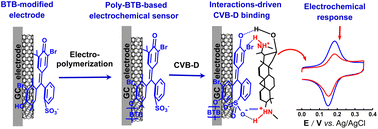A regenerable electrochemical sensor for electro-inactive cyclovirobuxine D detection in biological samples†
Abstract
Based on the pKa determination of cyclovirobuxine D (CVB-D) using the method of potentiometry, we predicted the ionization state of CVB-D at physiological pH. Thus, by taking advantage of the ionization state and consequent non-covalent interactions between protonated CVB-D and deprotonated polymerized bromothymol blue (poly-BTB) under physiological conditions, we developed a simple and reusable electrochemical sensor that contains a poly-BTB/SWNT-modified electrode for electro-inactive CVB-D detection in biological fluids using poly-BTB as both the recognition unit and the electrochemical probe. Upon being immersed in the solution of CVB-D, the poly BTB-based electrode shows a current decrease due to the interaction-driven binding of CVB-D on the electrode surface. The current decrease in the electrochemical sensor toward CVB-D concentration shows a linear relationship in the dynamic ranges of 0.01–1 μM and 1–50 μM with a detection limit of 1.65 nM based on 3σ. The sensor can be easily regenerated through the removal of the binding of CVB-D from the electrode surface by highly negatively charged heparin, and it presents high repeatability with an RSD of less than 4.0% for seven measurements. In animal experiments, the electrochemical sensor was selective and sensitive for CVB-D determination in plasma and liver homogenates. The electrochemical sensor is readily accessible, robust, and cost-effective and holds good promise for more applications in biological and clinical fields associated with CVB-D using less technically demanding and simple operating procedures.



 Please wait while we load your content...
Please wait while we load your content...